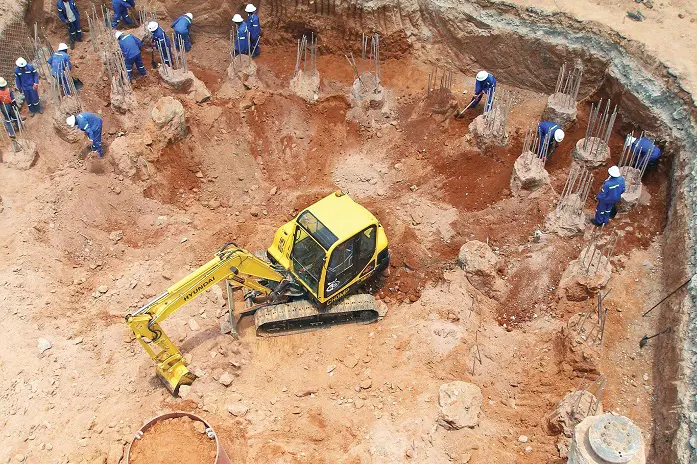The Evolution of Civil Consulting Engineers in the Modern Era
The Evolution of Civil Consulting Engineers in the Modern Era
Blog Article
The Vital Contributions of Geotechnical Designers in Assessing Soil Actions and Foundation Layout for Sustainable Facilities Advancement
Geotechnical designers offer as a keystone in the realm of lasting framework development, where their experience in evaluating dirt habits directly affects the safety and security and longevity of frameworks. By employing innovative methods such as Typical Infiltration Examinations and Cone Infiltration Testing, they carefully examine dirt homes, leading to educated decisions on foundation design.
Role of Geotechnical Designers

In enhancement to website examinations, geotechnical engineers evaluate potential dangers such as dirt liquefaction, incline security, and groundwater problems. They apply innovative design principles to develop services that reduce these threats, making sure that layouts follow pertinent codes and requirements. Their job usually entails cooperation with other engineering self-controls, engineers, and ecological scientists to produce integrated strategies to facilities development.
Furthermore, geotechnical designers add to lasting practices by promoting the usage of products and approaches that minimize ecological impact. Through their thorough understanding of dirt auto mechanics and geology, they play an essential role in cultivating safe, resilient, and lasting framework that satisfies the requirements of society while securing the setting.
Soil Habits Analysis Methods
Recognizing dirt actions is fundamental to educated decision-making in geotechnical design, as it directly affects the style and building processes. Various assessment methods are employed to review dirt properties, making sure precise predictions of its efficiency under different loading conditions.
One main method is the Conventional Infiltration Test (SPT), which offers understandings right into soil density and consistency through the resistance come across throughout infiltration. Similarly, Cone Infiltration Screening (CPT) provides a constant profile of dirt stratification and in-situ toughness parameters, making it possible for an extra in-depth understanding of subsurface conditions.
Research laboratory tests, such as Atterberg limitations, unconfined compressive stamina, and triaxial tests, are important for characterizing soil actions under regulated problems. These tests help with the decision of important parameters, consisting of shear stamina, compressibility, and permeability.

Structure Style Principles
Foundation style principles are important for making sure the stability and durability of frameworks, as they determine exactly how lots are transmitted from the superstructure to the underlying soil. These principles encompass various check it out factors to consider, consisting of load-bearing ability, settlement, and lateral security. A comprehensive understanding of dirt technicians is necessary for geotechnical engineers to assess the communication between the structure and the soil.
One trick principle is the ideal option of foundation kind, which might consist of superficial structures, such as spread footings, or deep foundations, like heaps or caissons, relying on soil problems and architectural tons - geotech engineer. The structure should be designed to lessen differential negotiation, which can lead to architectural damages

Sustainable Infrastructure Practices
Exactly how can we properly integrate sustainability into facilities methods? Lasting infrastructure practices begin with detailed site analyses, which review dirt behavior, regional ecosystems, and resource availability.
In addition, utilizing innovative building techniques, such as utilizing low-impact structures and recycled materials, dramatically minimizes the carbon impact of facilities jobs. Geotechnical engineers play an essential duty in selecting ideal materials that improve durability and sustainability, such as utilizing geo-synthetics to improve soil security and decrease erosion.
In addition, sustainable infrastructure methods need recurring surveillance and maintenance to ensure that frameworks stay resilient over time. Eventually, these techniques not only add to the durability of structures however also promote a healthier setting, lining up facilities advancement with wider sustainability purposes.
Instance Researches and Applications
Study in geotechnical engineering provide valuable understandings into the sensible applications of dirt behavior and lasting framework techniques. One remarkable example is the building and construction of the Burj Khalifa in Dubai, where extensive soil screening and evaluation were carried out to evaluate the distinct obstacles positioned by the region's loosened sand and high water table. Geotechnical engineers utilized progressed strategies such as dynamic More about the author penetrating and cone penetration screening to establish the dirt's load-bearing capability, inevitably causing the layout of a deep foundation system that supports this famous structure.
One more vital instance is the removal of the San Francisco-Oakland Bay Bridge after the 1989 Loma Prieta earthquake. Geotechnical evaluations disclosed the need for dirt stabilization strategies, including grouting and soil nailing, to improve the seismic durability of the structure. These interventions not just boosted the bridge's safety however also added to its durability and sustainability.
Such instance studies exhibit how geotechnical engineers play a crucial role in understanding soil behavior and using cutting-edge services to guarantee the architectural stability and sustainability of facilities jobs. geo tech engineering. Their knowledge is important in addressing the complicated tests posed by various soil conditions across varied geographic locations
Final Thought
Finally, the payments of geotechnical engineers are vital for the analysis of soil actions and the style of foundations, which are vital for sustainable facilities growth. With the application of advanced testing strategies and ingenious products, these experts guarantee the stability and safety and security of structures while lessening environmental impacts. The integration of lasting practices promotes durability in infrastructure jobs, highlighting the significance of cooperation among stakeholders to accomplish efficient building and construction solutions that fulfill both ecological and societal needs.
Geotechnical designers serve as a keystone in the world of lasting framework growth, where their knowledge in analyzing dirt habits straight affects the security and longevity of structures.Geotechnical engineers play an important role in the layout and construction of infrastructure by assessing dirt and rock behavior to guarantee stability and safety. A thorough understanding of soil technicians is crucial for geotechnical designers to assess the communication in between the dirt and the foundation.
Geotechnical evaluations revealed the need for soil stablizing strategies, including grouting and soil nailing, to boost the seismic durability of the structure.In verdict, the contributions of geotechnical designers are crucial for the analysis of dirt habits and the layout of structures, which are crucial for sustainable framework development.
Report this page